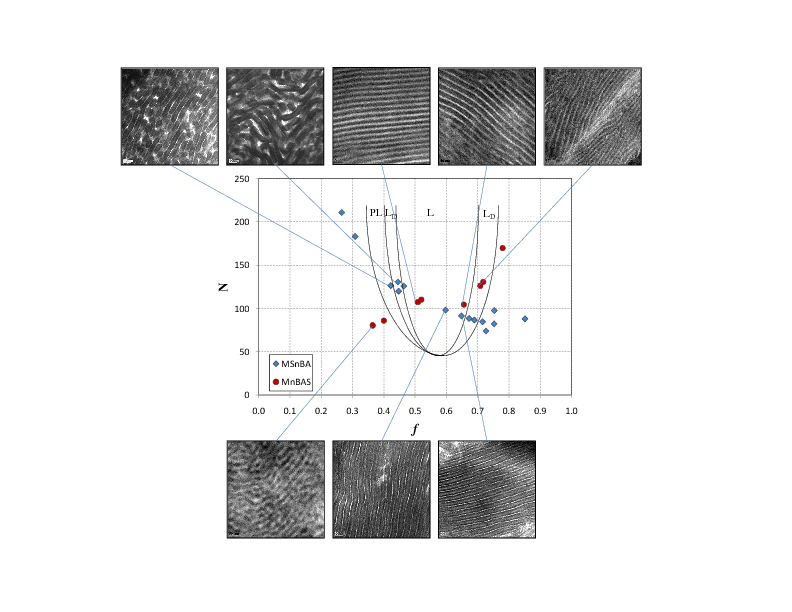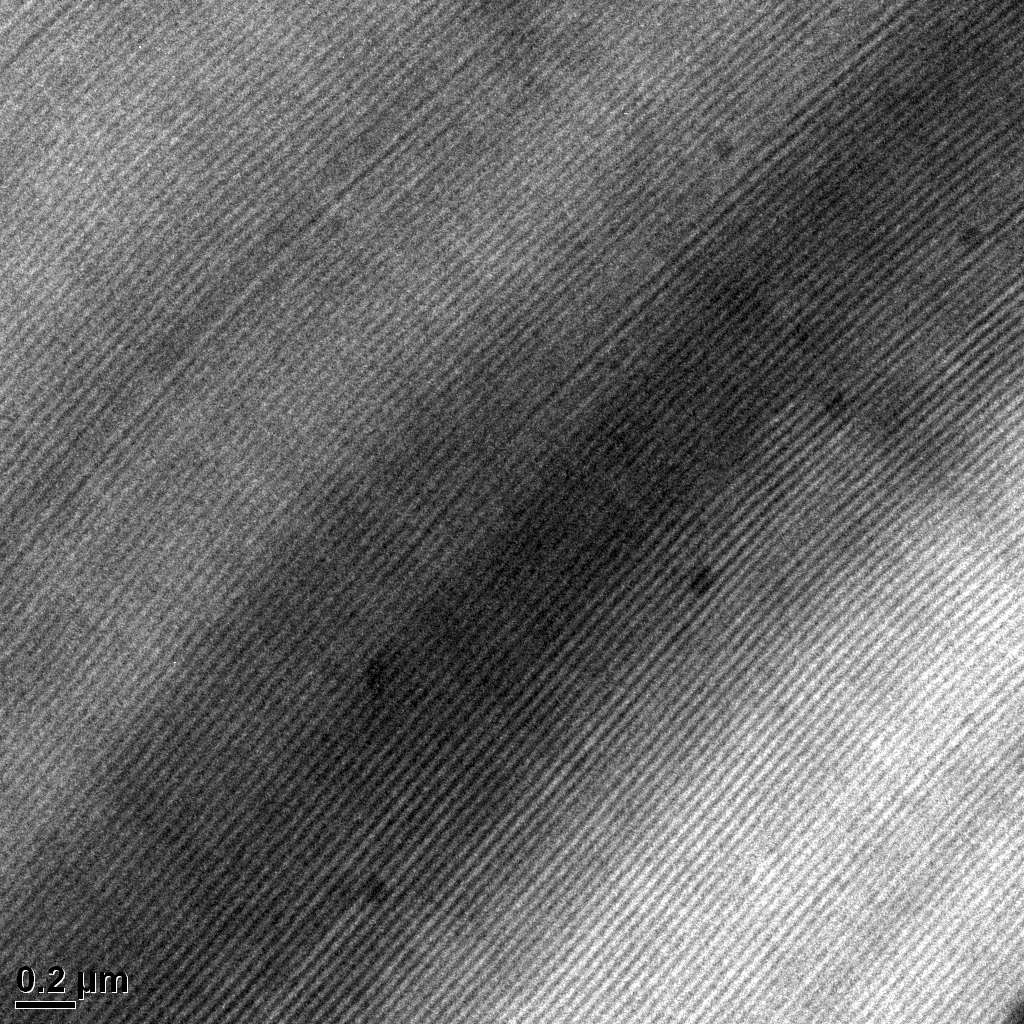AmericanChemicalSociety.com
55th Annual Report on Research 2010
Under Sponsorship of the ACS Petroleum Research Fund
Reports: G7 48399-G7: Thermodynamics of Layered-Silicate/Block Copolymeric Nanocomposites via Self-Assembly
Eric Cochran, Iowa State University
1 Major Research and Education Activities
This year we have undertaken 3 thrusts with respect to this project: 1.1 Structure-Morphology Relationships in ATRP-based BCPLS's The primary system of study has been montmorillonite clay (MMT) functionalized with ATRP-active surfactant molecules. Diblock copolymer brushes comprised of (a) poly(styrene-block-t-butyl acrylate) or (b) poly(styrene-block-n-butyl acrylate) over a wide range of molecular weight, composition, and block sequence have been prepared. At this point our primary focus has been to understand how these parameters influence the morphology of the phase-separated structures. A partial summary of our sample set and morphology data appears below. Preliminary mechanical property testing is now underway to begin to
add structure/property relationships to our body of knowledge.
This work has been conducted primarily by Ross Behling (graduating in
July 2010).
1.2 ROMP-based polyolefin BCPLS systems
Richard Kienzler is a first-year graduate student that is undertaking
this direction of the project. Building upon the work we have done
with structure/morphology relationships in our model systems based on
ATRP polymerization, Richard is learning to master ROMP
polymerizations and will subsequently be synthesizing polyolefin-based
thermoplastic elastomers containing polyethylene and hydrogenated
polynorbornenes. These new materials are expected to have excellent
mechanical properties, high crystallinity, and excellent potential for
commercial relevance.
1.3 New direction: Defect free nanocomposites with spherical nanofillers
Our strategy of integrating matrix and filler pioneered with the
polymer/clay system represents only an example of what I beleive to be
a broader paradigm in polymer nanocomposites. The TEM micrograph below
shows a clay/polymer sample where the polymer composition and
molecular weight are perfectly synergistic with the internal symmetry
and size of the planar supporting clay particles - the result is
nearly defect-free lamellae over the largest areas observable through
electron microscopy.
Preliminary mechanical property testing is now underway to begin to
add structure/property relationships to our body of knowledge.
This work has been conducted primarily by Ross Behling (graduating in
July 2010).
1.2 ROMP-based polyolefin BCPLS systems
Richard Kienzler is a first-year graduate student that is undertaking
this direction of the project. Building upon the work we have done
with structure/morphology relationships in our model systems based on
ATRP polymerization, Richard is learning to master ROMP
polymerizations and will subsequently be synthesizing polyolefin-based
thermoplastic elastomers containing polyethylene and hydrogenated
polynorbornenes. These new materials are expected to have excellent
mechanical properties, high crystallinity, and excellent potential for
commercial relevance.
1.3 New direction: Defect free nanocomposites with spherical nanofillers
Our strategy of integrating matrix and filler pioneered with the
polymer/clay system represents only an example of what I beleive to be
a broader paradigm in polymer nanocomposites. The TEM micrograph below
shows a clay/polymer sample where the polymer composition and
molecular weight are perfectly synergistic with the internal symmetry
and size of the planar supporting clay particles - the result is
nearly defect-free lamellae over the largest areas observable through
electron microscopy.
 The degrees of freedom in a polymer matrix are drastically reduced by
the attachement of one chain end to a surface to form a brush. The
energy penalty for defect structures in this scenario should be
expected to be drastically increased, and the likelihood of a defect
is in turn proportional to the Boltzmann weight of this energy
penalty. Inspired by this observation, Brandon Franck is investigating
the attachment of high molecular weight block copolymers to spherical
nanofillers such as gold particles and colloidal silica. Our
hypothesis is that under the appropriate conditions these particles
may be ordered on nearly perfect periodic lattices without the need
for external alignment protocols such as shear, electric field,
graphoepitaxy, etc...
Brandon is expected to graduate with an MS in Fall 2010. He may
continue to a Ph.D pending the quality of his thesis.
2 Major Findings
The degrees of freedom in a polymer matrix are drastically reduced by
the attachement of one chain end to a surface to form a brush. The
energy penalty for defect structures in this scenario should be
expected to be drastically increased, and the likelihood of a defect
is in turn proportional to the Boltzmann weight of this energy
penalty. Inspired by this observation, Brandon Franck is investigating
the attachment of high molecular weight block copolymers to spherical
nanofillers such as gold particles and colloidal silica. Our
hypothesis is that under the appropriate conditions these particles
may be ordered on nearly perfect periodic lattices without the need
for external alignment protocols such as shear, electric field,
graphoepitaxy, etc...
Brandon is expected to graduate with an MS in Fall 2010. He may
continue to a Ph.D pending the quality of his thesis.
2 Major Findings
- The kinetics of surface-initiated ATRP are strongly influenced by the graft density of tethered initiators in our system. These findings have been published.
- The development of morphology in diblock copolymer BCPLS is a rich interplay of chain stretching induced by crowding in the strong brush regime, the overall molar mass of the polymer, and its composition. We have identified a dichotomy between two important regimes of phase behavior: interparticle phase separation and intraparticle phase separation. We have documented these findings in a publication.
- 2 Ph. D. students have been supported through this award. Ross Behling will be receiving his Ph.D in July 2010.
- 1 MS student has been supported through this award. Brandon Franck will be receiving his degree in Fall 2010.
- I have presented my research to the students of my introductory polymers course in our department.
File translated from TEX by TTH, version 3.89.
On 04 Oct 2010, 11:08.
Moving Mountains; Dr. Surpless
Desert Sea Fossils; Dr. Olszewski
Lighting Up Metals; Dr. Assefa
Ecological Polymers; Dr. Miller
Copyright © American Chemical Society

